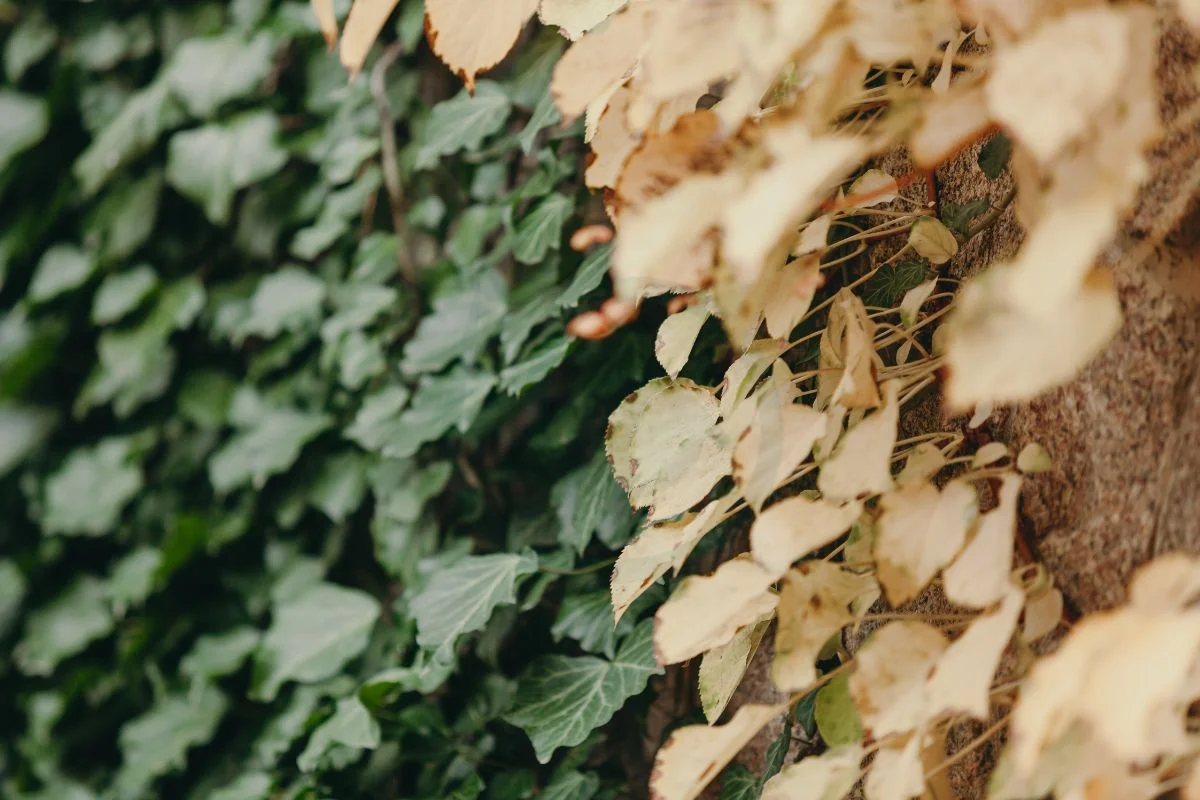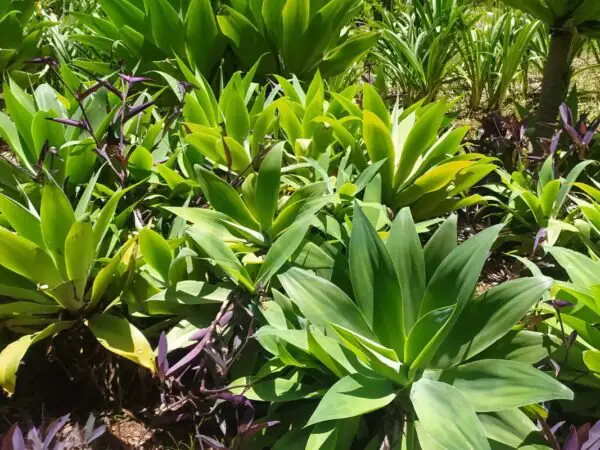
If you're noticing yellow leaves with green veins on your ivy, fret not. We've got you covered with expert advice and solutions to bring your ivy back to its lush green glory.
For a quick fix, consider adjusting watering habits and ensuring adequate sunlight exposure. Addressing potential nutrient deficiencies can help revive your ivy's vibrancy. Stay tuned for practical tips and tricks to address yellowing leaves on your beloved ivy plants.
Curious to learn more about caring for your ivy and preventing leaf discoloration? Keep reading as we delve deeper into the causes of yellow leaves on ivy and provide comprehensive guidance on maintaining healthy foliage.
Key Takeaways
- Identify the Cause: Determine the reason behind yellow leaves on ivy by considering factors like sunlight, water, or soil issues.
- Take Action: Once symptoms are identified, implement appropriate remedial measures such as adjusting watering or providing fertilizer.
- Manage Pests: Be vigilant about pest infestations and address them promptly to prevent further damage to the ivy plant.
- Prevent Future Issues: Implement preventative measures like regular pruning and proper drainage to maintain healthy ivy plants.
- Refer to Visual Guide: Use the visual diagnosis guide to aid in recognizing specific symptoms and addressing them effectively.
- Engage with the Community: Seek insights and advice from fellow gardeners or online forums to enhance your knowledge and troubleshoot ivy issues effectively.
Yellow Leaves Causes
Nutrient Deficiency
Identify nitrogen deficiency by observing yellowing lower leaves on the ivy plant. This lack of nitrogen leads to a pale, sickly appearance in the foliage. Recognize iron deficiency when green veins are present in conjunction with yellow tissue on the leaves. Balancing the plant's diet by providing appropriate nutrients is crucial to combat these deficiencies effectively.
Watering Issues
Overwatering
Detect overwatering by checking for soggy roots and yellow leaves that are wilting or dropping prematurely. To prevent overwatering, adjust watering frequency and quantity accordingly to avoid root rot and subsequent yellowing of leaves. Improving drainage in the plant's container or soil can help alleviate the effects of overwatering.
Underwatering
Combat underwatering by ensuring adequate hydration for the ivy plant through proper watering practices. Crispy, yellow leaves are indicative of underwatering, signaling the need for increased moisture levels. Consistent and sufficient hydration is essential to maintain healthy foliage and prevent further leaf discoloration.
Water Quality
Understand how chlorine and fluoride present in water sources can impact the coloration of ivy leaves. Monitoring water quality is essential to prevent any adverse effects on the overall health of the plant. Consider using filtered water to maintain optimal leaf color and minimize potential harm caused by impurities in regular tap water.
Soil Health
Maintain optimal soil health by ensuring proper drainage within the planting container or garden bed where the ivy is situated. Regularly check soil pH levels to facilitate healthy nutrient uptake by the plant's roots. Providing adequate aeration in the soil promotes both root and leaf health, contributing to vibrant foliage growth.
Identifying Symptoms
Discoloration Patterns
Yellowing patterns on ivy leaves can indicate various diseases. By understanding these patterns, you can pinpoint specific issues. Look for uniform yellowing across the leaf for signs of nutrient deficiencies. Adjust your care routine based on the type of discoloration observed, ensuring proper treatment.
Visual Aids
Photographs serve as valuable tools in identifying plant issues, including yellowing leaves on ivy. Seek visual references to assist in diagnosing the exact problem affecting your plant. Online resources offer visual guidance on different types of leaf discoloration, aiding in accurate identification and treatment.
Brown Spots
Brown spots on ivy leaves could signal calcium deficiencies or fungal infections. Promptly investigate and address brown spots to prevent further damage to the foliage. Distinguish between brown spots caused by pests and those resulting from diseases, allowing for targeted treatment strategies.
Remedial Measures
Watering Adjustments
Adjust watering practices to prevent yellowing leaves. Implement proper techniques for plant health maintenance. Monitor soil moisture levels to determine watering frequency.
Nutrient Management
Iron and Nitrogen
- Provide English Ivy with essential nutrients like iron and nitrogen.
- Ensure a balanced diet to prevent nutrient deficiencies.
- Incorporate slow-release fertilizers rich in iron and nitrogen.
pH Balance
- Monitor pH levels for proper nutrient uptake.
- Adjust pH balance to prevent nutrient deficiencies.
- Maintain optimal pH levels for healthy leaf color.
Expert Advice
Seek expert advice for proper English Ivy care. Consult professionals for guidance on diagnosing leaf issues. Reach out to specialists for assistance in maintaining plant health.
Pest Management
Common Pests
Identify common pests such as aphids, spider mites, and mealybugs that often plague ivy plants. These pests can weaken the plant and cause yellowing leaves. Implement pest control measures promptly to prevent infestations from spreading. Monitor your plants regularly for any signs of pest activity, such as stippling on leaves or sticky honeydew residue.
Organic Methods
Utilize organic control methods like soapy water sprays or neem oil to combat pests on your ivy plants effectively. These eco-friendly solutions are gentle on the environment while effectively managing pest populations. Consider natural remedies such as introducing beneficial insects like ladybugs to keep pest numbers in check without resorting to harmful chemicals.
- Soapy water sprays
- Neem oil applications
- Beneficial insect introduction
Chemical Options
Explore chemical control options like insecticidal soaps that target specific pests without harming beneficial insects. In cases of severe infestations, chemical treatments may be necessary to save your ivy plant from irreversible damage. However, always use chemical solutions as a last resort for effective pest management.
- Insecticidal soaps application
- Severe infestation treatment
- Last resort chemical solutions
Infestation Prevention
Prevent pest infestations by maintaining optimal plant health through proper watering and fertilization practices. Regularly inspect your ivy plants for early signs of pest activity, such as yellowing leaves or distorted growth patterns. Pruning stressed plants can also help reduce their susceptibility to pests by promoting overall plant vigor.
- Optimal plant health maintenance
- Early signs inspection routine
- Pruning for stress reduction
Preventative Measures
Plant Placement
Position English Ivy in bright, indirect sunlight for optimal growth. Avoid direct sunlight to prevent leaf damage. Choose suitable locations for thriving ivy plants.
Soil Maintenance
Maintain soil quality with proper aeration and drainage. Regularly check moisture levels to prevent overwatering. Ensure conducive soil pH levels for healthy plant growth.
Visual Diagnosis Guide
Recognizing Signs
English Ivy owners should recognize signs of stress to maintain plant health effectively. Monitoring leaf color changes is crucial for early detection of issues. Identifying early warning signs allows for timely intervention to prevent severe damage.
Clues on Leaves
Inspecting leaves for clues is essential in diagnosing plant problems. Analyzing leaf discoloration patterns offers valuable insights into the overall health of the ivy. Utilize leaf characteristics as indicators to pinpoint potential nutrient deficiencies.
Community Insights
Real Talk
English Ivy faces challenges like overwatering and insufficient light, leading to yellow leaves. Misconceptions include underestimating the impact of poor drainage on plant health. To combat yellowing leaves, ensure proper watering and adequate sunlight exposure.
- Challenges: Overwatering can harm English Ivy by causing root rot, leading to yellow leaves.
- Misconceptions: Many overlook the importance of well-draining soil for preventing yellow leaves.
- Tips: Maintain proper watering schedules and provide enough sunlight for healthy English Ivy growth.
Support English Ivy care by offering guidance on identifying and addressing issues causing yellow leaves. Troubleshooting involves checking soil moisture levels and adjusting watering accordingly. Online communities provide valuable insights into nurturing thriving English Ivy plants.
- Identify Yellow Leaves: Check for signs of overwatering or inadequate light causing leaf discoloration.
- Adjust Watering: Ensure proper drainage to prevent waterlogged soil, which can lead to yellowing leaves.
- Seek Online Support: Join gardening forums or social media groups for expert advice on English Ivy care.
Help and Support
Assist in diagnosing yellow leaves by examining soil moisture levels and potential root rot issues. Troubleshooting may involve repotting in well-draining soil to revive ailing English Ivy plants. Engaging with online communities offers diverse perspectives on nurturing healthy ivy.
- Diagnosing Issues: Test soil moisture levels to determine if overwatering is causing yellow leaves.
- Troubleshooting Steps: Repot English Ivy in well-draining soil to promote healthy root growth and prevent further leaf discoloration.
- Online Communities: Connect with fellow gardeners online to share experiences and seek advice on maintaining vibrant English Ivy plants.
Additional Resources
English Ivy Care
Proper care is essential for maintaining healthy English Ivy, ensuring vibrant foliage and overall plant well-being. Regular watering, adequate sunlight exposure, and proper pruning are key practices to uphold the plant's health. Avoid overwatering as it can lead to root rot, impacting the ivy's vitality.
To nurture healthy English Ivy foliage, consider providing consistent moisture levels by watering when the soil feels dry to the touch. Ensure the plant receives indirect sunlight or partial shade to prevent leaf scorching. Pruning dead or yellow leaves promotes new growth and enhances the plant's appearance.
Further Reading
For those seeking more detailed insights into English Ivy care, there are various resources available for comprehensive knowledge. Explore gardening books that delve into plant care techniques specific to English Ivy. Online forums and websites dedicated to gardening offer valuable tips and tricks for nurturing ivy plants effectively.
Delve deeper into English Ivy care by referring to botanical journals or publications focusing on indoor plants. These resources provide in-depth information on soil requirements, pest management strategies, and troubleshooting common issues with English Ivy. By expanding your knowledge base through recommended reading materials, you can become a proficient caretaker of this beloved plant.
Summary
In understanding the causes of yellow leaves on ivy, identifying symptoms, and implementing remedial and preventative measures, you've equipped yourself with the knowledge to nurture your ivy plants effectively. By managing pests and referring to the visual diagnosis guide and community insights, you can ensure the health and vibrancy of your ivy foliage. Utilize the additional resources provided to deepen your understanding and tackle any challenges that may arise in caring for your plants. Take proactive steps to maintain your ivy's well-being and enjoy lush, green foliage year-round.
Enhance your gardening skills by applying these insights to care for your ivy plants better. Share this valuable information with fellow plant enthusiasts to create a community dedicated to fostering healthy gardens. Your dedication will yield thriving ivy plants that beautify your surroundings. Keep growing and nurturing your green companions!
Frequently Asked Questions
What are the common causes of yellow leaves on ivy?
Yellow leaves on ivy can be caused by overwatering, underwatering, nutrient deficiencies, or pest infestations. Ensure proper watering, adequate sunlight, and regular fertilization to prevent yellowing.
How can I identify symptoms of yellow leaves on my ivy plant?
Look for signs such as leaf discoloration, wilting, curling edges, and unusual spots. Inspect the undersides of leaves for pests. Conduct a soil test to check for nutrient deficiencies contributing to yellowing.
What are some effective remedial measures for yellow leaves on ivy?
Trim affected yellow leaves to encourage new growth. Adjust watering schedule based on plant needs. Apply a balanced fertilizer to address nutrient deficiencies. Treat any pest infestations promptly with appropriate methods.
How can I manage pests affecting my ivy plant with yellow leaves?
Identify the specific pest causing damage to your ivy plant. Use organic or chemical treatments tailored to the pest type. Regularly inspect your plant for early detection and prevention of pest issues.
What preventative measures can I take to avoid yellow leaves on my ivy?
Ensure proper drainage in the soil to prevent waterlogging. Maintain consistent watering practices and avoid overfertilizing. Keep an eye out for early signs of stress in your plant and address them promptly. Regularly clean and inspect your plant for pests or diseases.
Refer to our detailed visual guide showcasing common symptoms associated with yellow leaves on ivy plants due to various causes such as nutrient deficiencies, pests, and environmental stressors.
Where can I find additional resources for addressing yellow leaves on my ivy plant?
Explore our recommended resources including articles, videos, and expert tips on caring for ivy plants, diagnosing leaf discoloration issues, and implementing effective solutions to maintain healthy foliage.
Image Source: Paid image from CANVA




